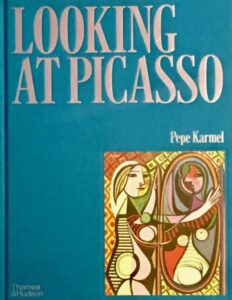This new book is well designed with many good quality illustrations on substantial matte paper and each chapter defined by double page differently coloured paper so that it’s a pleasure to navigate it.
Karmel begins with an account of Picasso’s life, mentioning his dealers and his relationships with women and pointing out that he was famous by 1918, when he was 37. That he visited his lover Eva Gouel daily as she died of cancer in 1915 was new to me.
Under ‘symbolism’ Karmel deals mostly with ‘Les Demoiselles d’Avignon’, giving the views of different critics who see in it virility, domination of women, savagery, anti-colonialism, and sexuality,
Surprisingly he ignores the story of Picasso’s friend Casaquemas who killed himself because of an unhappy love affair, which I thought was relevant. I can see the picture as depicting that women in a brothel are made into monsters by their exploitation and I think the point here is that symbols have many possible interpretations.
In ‘Cubism’’ Karmel explains carefully the workings of this new phenomenon with its inventiveness, paralleled in the writings of Joyce and Woolf. This encourages the reader to re examine the compositions.
Under ‘Surrealism’ he gives his personal interpretations of particular paintings in some detail such as seeing a key in a Dinard Beach picture as ‘a symbol for the artist’s hidden self, waiting to be unlocked by a woman bearing the right key.’
He tends to find obscenity and brutality where I could describe a playful freedom. I hadn’t previously been aware of depiction of oral sex performed on a woman by a man in some Picassos.
Chapter five is about Picasso’s varied use of classicism and again a parallel use of Greek myth in a modern setting in Joyce’s writing.
Lastly Karmel attends to politics, telling us that before 1936 Picasso was not involved and also that Guernica was not at first admired although Herbert Read called it ‘a modern Calvary.’
He refers also to Orwell’s use of animal allegory.
The book then ends abruptly, saying that the late works need future evaluation but calling them pornographic and deliberately crude, whilst I might have spoken of wry humour and self satire.
I found this book interesting, getting me to take a new look at familiar images, and to notice my reactions where they differed from the author’s.
It was not a revelatory clearly unified analysis nor was it unmasking Picasso as a misogynist. I liked the contextual comparisons to contemporary writing which counteract the usual story of an isolated genius.
Picasso remains in his complexity which in its various forms reflects whatever one brings to it.
However, Pepe Karmel provides a well researched and thoughtful commentary.
Looking at Picasso
Pepe Karmel.
Thames and Hudson Ltd; 1st edition
Hardback. 200 pages
ISBN 978-0500026045

